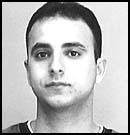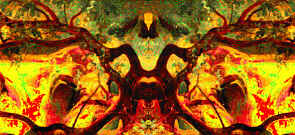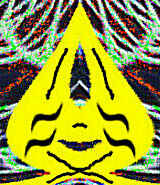
| <<
Nov 23| HISTORY “4” “2”DAY
|Nov 25 >> Events, deaths, births, of 24 NOV v.5.a0 [For Nov 24 Julian go to Gregorian date: 1582~1699: Dec 04 — 1700s: Dec 05 — 1800s: Dec 06 — 1900~2099: Dec 07] |
| ^
On
a 24 November: 2002 Run-off presidential election in Ecuador among the two top vote getters of the 11 candidates in the 20 October 2002 first round. With leftist support, Lucio Gutiérrez, 45 (who got 20.4% in October), gets 54% of the vote and wins over banana-and-shipping billionaire Alvaro Noboa, 52 (who had 17.4% and now gets 46%). Gutiérrez earned his reputation as a corruption fighter in January 2000 when he led a group of disgruntled junior army officers and 5000 Amerindian protesters in a coup that ousted President Jamil Mahuad in the midst of Ecuador's worst economic crisis in decades. Gutiérrez was expelled from the army for his rebellion and spent six months in a military prison. 2002 Elections in Austria. The Social Democrats, led by Alfred Gusenbauer, get 37% of the votes, behind the 42% of 57-years-old Chancellor Schüssel's People's Party, whose coalition partners of the extremist right-wing Freedom Party, led by Jörg Haider, drop from 27% of the vote in the last elections (in 1999) to 10%. The Greens get 9%. 2000 The US Supreme Court intervenes into the presidential election recount, agreeing to consider George W. Bush's appeal against the hand recounting of ballots in Florida. 1999 Elian Gonzalez, 5, drifts in the Florida straits, alone on an inner tube, after his mother and 10 others drowned after their boat capsized as they were trying to reach the US from Cuba. 1998 A federal judge rules that a Virginia library constitutionally could not block Internet pornography from library computers. The court said that, if county libraries chose to offer Internet service, they could not violate the right to free expression on the Net, and that it was unconstitutional for the library to use filtering software.
|
| 1997 RealNetworks, an Internet pioneer that developed
streaming audio and video technology, makes a public offering on this day
in 1997. The company, once co-owned by Microsoft and formerly called Progressive
Networks, takes in more than $500 million on its first day of trading. 1995 Irish voters passed a referendum removing the constitutional ban on divorce. 1993 The Brady bill handgun-control legislation is passed by the US Congress. President Clinton would signed it into law on 30 November 1993. 1989 After more than a week of popular protests, the hard-line Communist Party leadership resigns in Czechoslovakia, and Czech reform politician Alexander Dubcek makes his first public appearance in Prague since the Soviet invasion of 1968. 1987 The US and the USSR agree to decomission short- and medium-range nuclear missiles. 1983 PLO exchanges 6 Israeli prisoners for 4500 Palestinians & Lebanese 1979 The United States admits that thousands of troops in Vietnam were exposed to the toxic Agent Orange, used for defoliation. 1977 Greece announces the discovery of the tomb of King Philip II, father of Alexander the Great.
1966 1st TV station in Congo, Kinshasa (Za‹re) 1964 Rebellion ends in Zaire |
1958 Mali becomes an autonomous state within French Community 1950 UN troops begin an assault into the rest of North Korea, hoping to end the Korean War by Christmas. 1949 The Iron and Steel Act nationalizes the steel industry in Britain.
1944 US bombers based on Saipan, 1st attack Tokyo |
1927 US Federal officials battle 1200 inmates who revolted in Folsom Prison. 1912 Austria denounces Serbian gains in the Balkans; Russia and France back Serbia while Italy and Germany back Austria. 1903 Clyde Coleman of NYC patents automobile electric starter 1901 University of Athens held by rioting students opposing translation of the New Testament into modern Greek
1874 Joseph F Glidden patents barbed wire, which would make the farming of the Great Plains possible. 1864 Kit Carson and his 1st Cavalry, New Mexico Volunteers, attack a camp of Kiowa Indians in the First Battle of Adobe Walls. 1864 Skirmish at Columbia, Tennessee. 1863 In the Battle Above the Clouds, Union Maj. Gen. Joseph Hooker's forces take Lookout Mountain, near Chattanooga, Tennessee.
1860 En France, le Corps législatif acquiert le droit d’adresse. C'est une première atteinte au pouvoir absolu de Napoléon III. Sous la pression de l’opinion et aussi sous l’effet de ses propres penchants politiques, l'empereur entreprend de démocratiser le régime. 1848 à l'imitation des révolutionnaires français, le peuple de Rome fomente une émeute. Le pape s’enfuit à Gaëte.
|
1655 Oliver Cromwell prohibits Anglican services in favor of Puritan forms. 1642 Abel Janzoon Tasman discovers Van Diemen's Land (Tasmania) — Le navigateur hollandais Abal Tasman découvre une île qui portera son nom, la Tasmanie. Cette île des mers australes, à la faune et à la flore originales, fait aujourd’hui partie de la fédération australienne. — Le navigateur hollandais Abel Tasman découvre au large de l'Australie une île à laquelle il donne le nom du gouverneur des Indes Orientales Hollandaises, Van Diemen. En 1853, elle sera rebatisée Tasmanie. Elle dépend administrativement de l'Australie, a un climat chaud et humide ; elle tire l'essentiel de ses ressources de l'agriculture ; l'élevage des bovins y est florissant et les pommes de Tasmanie sont exportées dans le monde entier. 1639 1st observation of transit of Venus occurred (only 2, record event) 1564 First Index of Prohibited books is published with papal approval. 1542 The English defeat the Scots at the Battle of Solway Moss in England. 0642 Theodore I begins his reign as Pope 0496 Anastasius II begins his reign as Pope — 166 -BC- Origin of Era of Maccabees |
2005:: 35 persons including a suicide car bomber at the general hospital in Mahmoudiya, Iraq, which was being visited by US civil affairs soldiers, none of whom is killed. The dead include 7 policemen, 3 Iraqi soldiers, 1 doctor and 5 members of the medical staff. 39 persons are wounded. — (051124) 2005 Five persons including a suicide car bomber at a market in Hilla, Iraq. — (051124) 2005 Three bodyguard as terrorists, in Baghdad, Iraq, shoot at the motorcade of the minister of industry, in which he was not. — (051124) 2005 Four persons whose bodies are are found, tortured, strangled, and shot in Yusifiya, Iraq. — (051124) 2005 Two Iraqi soldiers, by a roadside bomb next to their patrol in Baiji, Iraq. — (051124) 2005 An official in the city council of Tikrit, Iraq, shot by terrorrists. — (051124) 2005 A policeman, in an attack by terrorists in Baghdad, Iraq. Two policemen are wounded. — (051124) 2005 General Mahdi Kassem, former chief of traffic police, assassinated in Baghdad, Iraq. — (051124) 2005 Radi Ismail Jawad, a high-ranking official in the Iraqi Ministry of industry, assassinated in Baghdad, Iraq. — (051124) 2005 Sheikh Fadel Sarhid Ali, three of his sons, and a son-in-law, shot by terrorists dressed as Iraqi soldiers, who broke into his Baghdad home at 04:00 (01:00 UT), after arriving in 10 army-type vehicles. The sheikh was a Sunni Arab tribal chief. — (051124) 2004 Dominic Middleton, 12, and Christina Middleton, 1, shot at 07:15 (12:15 UT) by their father, Everett George, 34, with his 9-mm Hi-Point pistol, in the Middletons' 2nd-floor apartment in the Marion Scott Houses on 129th Street near Lexington Avenue, in Harlem, New York, into which George had forced his way. The pistol jams after the two shots, so that George flees instead of shooting Tishaun Middleton, 31, the children's mother and his former mate, whom, by court order, he was prohibited from approaching. He had sprayed Mace into her face and punched her in the stomach just before shooting the children. He is arrested later. George worked as a probationary prison guard from August 1997 to May 1998, was reinstated on 07 December 2000 and fired on 12 December 2000. His application to the NY City Police was rejected in 2002. At various times he worked as a bouncer at a Midtown nightclub and as a producer at Black Entertainment Records. Dominic Middleton was a shy, mentally handicapped boy. 2004 Arthur Hailey, British-born (05 Apr 1920) Canadian author of novels: Runway Zero-Eight (1958), The Final Diagnosis (1959), In High Places (1960), Hotel (1965), Airport (1968), Wheels (1971), The Moneychangers (1975), Overload (1979), Strong Medicine (1984), The Evening News (1990), Detective (1997). — (051122) 2004 Joseph Hansen, born on 19 July 1923, US author of a series of crime novels featuring the homosexual insurance investigator and detective Dave Brandstetter. Hansen, who also wrote under the pseudonyms Rose Brock and James Colton, began his career as an editor, novelist, and journalist in the mid-1960s. He taught writing at the University of California, Los Angeles, from 1977 to 1986. In Fadeout (1970), the first novel to feature Brandstetter, the detective falls in love with a man whom he clears of murder charges. Death Claims (1973) is about surviving the death of a lover. Brandstetter investigates the murder of the owner of a bar for homosexuals in Troublemaker (1975). In Early Graves (1987) he comes out of retirement to trace a serial killer who murders men who have AIDS. Brandstetter also appears in several other novels and in Brandstetter and Others (1984), a collection of short stories. In addition to the Brandstetter series, Hansen wrote the novels A Smile in His Lifetime (1981), Backtrack (1982), Job's Year (1983), and Jack of Hearts (1995), as well as the short-story collections The Dog and Other Stories (1979), Bohannon's Book (1988), and Bohannon's Country (1993). Hansen was also noted for writing poems, teaching workshops, and hosting the 1960's radio show Homosexuality Today. Hansen was married to artist Jane Bancroft [1925-1994] from 1943 to her death. He said that their relationship was that of, “a gay man and a woman who happened to love each other.” Hansen's only survivor was a daughter who underwent a sex change operation to become a “man”. — (051122) 2004 Elijah Mwangale, 65, Kenyan politician, former member of Parliament, and foreign minister from 1983 to 1987. — (051122) 2004 James Wong, 64, Hong Kong lyricist, actor, director, talk show host and author. — (051122) 2004 Larry Brown, US author born on 09 July 1951. — (051122) 2004 Twenty-five fighters of the rebel Sudan Liberation Army, when, in violation of a cease-fire, the government air force bombs the village Tadit, 40 km southwest of the North Darfur capital, El Fasher. 2003 Nfumu-Ngui “Floquet de Neu”, 40, killed for suffering from skin cancer since 2001, at the Barcelona zoo, where he was imprisoned since the age of 3, after have been captured in his native Equatorial Guinea. He was the world's only know albino gorilla. Nfumu was affected by an oculocutaneous albinism that could be equivalent to Type I-B or yellow albinism in human beings. This seems to be associated with reduced but sufficient levels of residual tyorinase activity to produce small amounts of pigment. His skin was totally white and the membranes were pale pink. hairs were also white although in some areas (head and shoulders) they were light cream yellow. Iris was blue to gray and small amounts of pigment were found in the iridial stroma and in the retina. Pigment was absent in the posterior epithelium and the iris was fully translucent on globe transllumination. Nfumu means “white” in the fang language of those who captured him when he was 2, after killing his mother and all his relatives. The Barcelona zoo in vain tried to breed him to produce more albino gorillas. He had 22 children, but all were dark gorillas apparently normal, though all the males were sterile. The zoo even tried to breed him to his own daughters, but Nfumu's standards of morality were higher than those of his jailers, and he always refused to commit incest. Because of his albinism, Nfumu squinted a lot in the bright sunlight and often people mistakenly thought that he was grimacing or angry. [photo below] |
 |
| 2003:: 33 students, in fire which starts at 02:00 due to a short-circuit in room 203 on the 2nd floor of a filthy 5-story dormitory of Patrice Lumumba People's Frienship University in Moscow, which housed, 3 instead of the designed 2 to a room, 272 students newly arrived from Vietnam, Ecuador, Tahiti, Afghanistan, Tajikistan, Angola, and mostly China, who were awaiting medical check-ups. At least 3 of the deaths and many of the injuries to some 170 persons, were caused by jumping from the upper floors, as one of the two stairwells was blocked, besides the second floor being engulfed in flames. It is 05:30 by the time firefighters put out the fire. [photo below] |
 |
| 2002 At least 5 worshippers and one policeman, during
a 19:00 to 19:30 gun battle between Indian security forces and independentist
guerillas who storm the 150-year-old Raghunath temple complex in the city
of Jammu, in Indian-occupied Kashmir. 2002 John Rawls, of heart failure, incapacitated since a 1995 stroke. Born on 21 February 1921 he was a US political theorist whose A Theory of Justice (1971) insisted that a society ought not to seek the greatest good of the greatest number of people at the expense of the rights of minorities. 2001: 24 persons aboard Crossair Flight LX3597 from Berlin which crashes just after 22:00 as it approaches Zurich Airport to land, with rain and some snow. On board are 28 passengers and five crew members. The plane goes down in a wooded area in Birchwil, some 3 km east of the airport and its middle section is engulfed in a fireball. The plane is a Jumbolino (= Avro RJ), manufactured by Britain's BAE Aircraft Services Group, a small, four-engine jetliner that can seat 97 passengers. 2000 Ghassan Karaan, 20, and Ayfar Hasis, 15, Palestinians killed by Israeli gunfire in rock-throwing clashes in the West Bank towns of Qalqilya and Jenin. 2000 Ziad Abu Jeser, 20, shot more than a dozen times by Israelis, in the Gaza town of Rafah.  2000
Ariel Jeraffi, 40, Israeli of Petah Tikva, the father of three,
killed by Palestinian fire as he traveled near Otzarin. Jeraffi, a civilian
employed by the IDF, had been carrying out construction work in the settlement
of Barkan. Four bullets penetrated the vehicle in which he was traveling,
one of them penetrating his flack jacket and piercing his abdomen. The Israeli
army imposed a curfew on Otzarin. This brings the total of dead from the
al-Aqsa intifadah to 271, at least 85% of whom are Palestinians. 2000
Ariel Jeraffi, 40, Israeli of Petah Tikva, the father of three,
killed by Palestinian fire as he traveled near Otzarin. Jeraffi, a civilian
employed by the IDF, had been carrying out construction work in the settlement
of Barkan. Four bullets penetrated the vehicle in which he was traveling,
one of them penetrating his flack jacket and piercing his abdomen. The Israeli
army imposed a curfew on Otzarin. This brings the total of dead from the
al-Aqsa intifadah to 271, at least 85% of whom are Palestinians.2000 Sami Amer, 32, and Naheed Amer, 26, Palestinian brothers killed by shrapnel from Israeli rocket in the West Bank village of Kufr Kalil, where they were leaders of Fatah. 2000 Sharon Arameh, 25, [photo >] of Ashkelon, Israeli army major, by Palestinian sniper fire in the afternoon, during fighting near the Gaza Strip settlement of Neveh Dekalim. 2000 Six persons, by armed militants who kidnapped them from a bus stop, in Akhala, India. The Lashkar-e-Tayyiba is probably responsible.
1964 Paul Carlson, Christian doctor in the Congo, killed minutes before Belgian paratroops land to attempt rescue of the hostages held by Simba rebels. 1963 Lee Harvey Oswald, 24, alleged assassin of President John F. Kennedy, is shot to death by Jack Ruby, a Dallas nightclub owner, at 11:21 in the basement of the Dallas police station, on live TV. — MORE.
1939 Some 120 students in Czechoslovakia, executed by the Gestapo for alleged anti-Nazi plotting.
1750 Frans Breydel, Flemish artist born on 08 September 1679. 1693 Nicolaas Maes (or Maas), Dutch painter specialized in portraits, born in 1634 — MORE ON MAES AT ART “4” NOVEMBER with links to images. 1682 Picard Jean Michel Picart (or Picard), Flemish artist born in 1600. 1572 John Knox Scottish preacher. KNOX ONLINE: The First Blast of the Trumpet Against the Monstrous Regiment of Women , The Order of Excommunication and of Public Repentance 0029 Jesus of Nazareth (?) if marked by the total solar eclipse of 1m58s at 09:35 UT, visible in Judaea at about 12:00 local solar time. |
1947 The Pearl, novel by John Steinbeck, is first published. 1934 Martin Charnin Broadway lyricist (Annie, West Side Story)
1909 Gerhard Gentzen, mathematician. 1901 William Vanderbilt (politician)
|
| 1884 Itzhak Ben-Zvi, second president of Israel(1952-63).
He died on 23 April 1963. 1879 Sommerville, mathematician. 1877 Alben W Barkley, Graves County KY, (35th Vice President-D-1949-53). He died on 30 April 1956. 1875 Louis Mathieu Verdilhan, French artist who died on 15 November 1928. 1871 National Rifle Association, is incorporated (NYC) and Maj. Gen. Ambrose E. Burnside. is named its first president. 1868 Scott Joplin US, entertainer, King of ragtime music, composer (Maple Leaf Rag, The Entertainer) who died on 01 April 1917. 1864 Henri-Marie-Raymond de Toulouse-Lautrec-Monfa, French painter who died on 09 September 1901. — Le peintre Henri de Toulouse-Lautrec naît à Albi, dans une riche famille de la haute aristocratie. — MORE ON TOULOUSE~LAUTREC AT ART “4” NOVEMBER with links to images.
|
|||||||||||||
1824 Charles Michel Marie Verlat, Belgian artist who died on 23 October 1890. 1792 Johann Adam Klein, German artist who died on 21 May 1875.
1713 Laurence Sterne Irish-born English novelist and humorist, author of Tristram Shandy (1759-67), an early novel in which story is subordinate to the free associations and digressions of its narrator. He is also known for the novel A Sentimental Journey (1768). He died on 18 March 1768. — STERNE ONLINE: The Life and Opinions of Tristram Shandy, Gentleman — The Life and Opinions of Tristram Shandy, Gentleman — A Sentimental Journey through France and Italy — A Sentimental Journey through France and Italy. 1689 Gasparo Diziani, Italian artist who died in 1767. — more with links to images. 1683 Carel van Faleus, Dutch artist who died on 27 May 1733. 1632 Benedict de "Baruch" Spinoza, Amsterdam, rationalist philosopher, who died on 21 February 1677. — SPINOZA ONLINE: (in English translations): The Ethics, On the Improvement of the Understanding, On the Improvement of the Understanding, On the Improvement of the Understanding, Selected Works, A Theologico-Political Treatise. 1592 Pieter (or Peeter) Snayers, Flemish artist who died in 1667. 1472 Pietro (or Piero) di Torrigiani (or Torrisano), Italian artist who died in July or August 1528. |
 |
 |